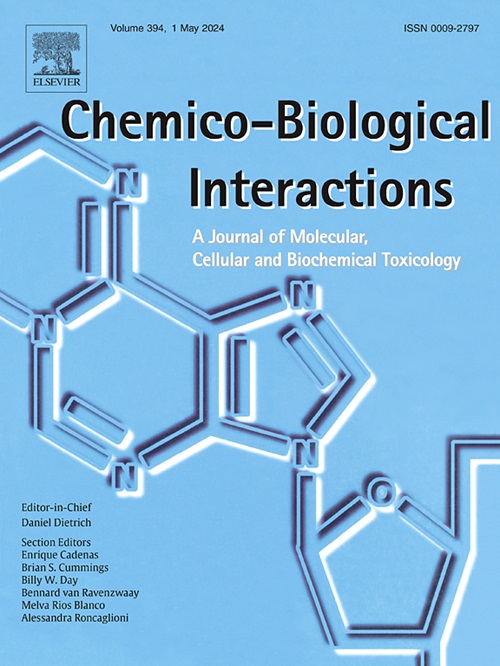Myriscagayanone C是一种从myristica cagayanensis果实中提取的新化合物,通过特异性阻止Akt在人中性粒细胞中的易位来抑制fmlp诱导的呼吸爆发。
IF 4.7
2区 医学
Q1 BIOCHEMISTRY & MOLECULAR BIOLOGY
引用次数: 0
摘要
过度活化的中性粒细胞可引起炎症性疾病。中性粒细胞具有多种表面受体,包括g蛋白偶联的趋化受体,其有助于识别病原体攻击和炎症环境。因此,靶向g蛋白偶联的趋化剂受体及其下游分子对于防止中性粒细胞异常活化具有重要意义。本文研究了从卡加杨肉豆蔻果实中提取的一种新化合物myriscagayanone C对fMLP诱导的中性粒细胞呼吸爆发的作用及其机制。免疫印迹法研究myriscagayanone C通过破坏Akt向细胞膜的易位来抑制fmlp诱导的呼吸爆发的机制。简而言之,myriscagayanone C抑制fMLP诱导的人中性粒细胞超氧阴离子的产生呈浓度依赖性(IC50: 4.73±0.68 μM)。Myriscagayanone C阻断fmlp诱导的Akt转位至细胞膜,分别抑制PDK1Y373/376和mTORS2481对AktT308和AktS473的磷酸化。Myriscagayanone C抑制fmlp诱导的p47phox磷酸化和易位。Myriscagayanone C不抑制PI3K的活性、磷脂酰肌醇(3,4,5)-三磷酸的数量,也不抑制磷酸化的pdk1y373 /376和-mTORS2481向膜的移位。Myriscagayanone C不抑制fmlp诱导的PKC、Src、ERK1/2、p38磷酸化和细胞内钙动员。myriscaganone C对fMLP诱导的趋化性和CD11b表达无抑制作用。Myriscagayanone C不抑制pma诱导的超氧阴离子产生和中性粒细胞胞外陷阱的形成。根据这些数据,myriscagayanone C通过阻断Akt向质膜的易位来抑制fmlp诱导的中性粒细胞超氧阴离子的产生,从而通过阻止p47phox的磷酸化和易位影响NADPH氧化酶的活性。本文章由计算机程序翻译,如有差异,请以英文原文为准。

Myriscagayanone C, a new compound from the fruit of myristica cagayanensis, inhibits fMLP-induced respiratory bursts by specifically preventing Akt translocation in human neutrophils
Neutrophils that are overactivated can cause inflammatory diseases. Neutrophils possess various surface receptors, including G-protein-coupled chemoattractant receptors, which assist in recognizing pathogen attacks and the inflammatory environment. Therefore, targeting G-protein-coupled chemoattractant receptors and their downstream molecules is important for preventing abnormal neutrophil activation. This study examines the effects and underlying mechanism of myriscagayanone C, a new compound obtained from the fruit of myristica cagayanensis, on neutrophil respiratory burst induced by fMLP. The immunoblotting assay was conducted to assess the mechanisms by which myriscagayanone C inhibits fMLP-induced respiratory burst by disrupting the translocation of Akt to the cellular membrane. Briefly, myriscagayanone C suppressed the production of superoxide anions induced by fMLP on human neutrophils in a concentration-dependent manner (IC50: 4.73 ± 0.68 μM). Myriscagayanone C blocked fMLP-induced Akt translocation to the cell membrane, inhibiting AktT308 and AktS473 phosphorylation by PDK1Y373/376 and mTORS2481, respectively. Myriscagayanone C inhibited fMLP-induced p47phox phosphorylation and translocation. Myriscagayanone C did not inhibit the activity of PI3K, the amount of phosphatidylinositol (3, 4, 5)-trisphosphate, or the translocation of phosphorylated-PDK1Y373/376 and -mTORS2481 to the membrane. Myriscagayanone C did not inhibit fMLP-induced PKC, Src, ERK1/2, p38 phosphorylation, and intracellular calcium mobilization. Myriscagayanone C did not inhibit the chemotaxis and CD11b expression induced by fMLP. Myriscagayanone C did not inhibit PMA-induced superoxide anion production and neutrophil extracellular trap formation. According to this data, myriscagayanone C inhibits fMLP-induced neutrophil superoxide anion production by interrupting the translocation of Akt to the plasma membrane, which affects the NADPH oxidase activity by preventing p47phox phosphorylation and translocation.
求助全文
通过发布文献求助,成功后即可免费获取论文全文。
去求助
来源期刊
CiteScore
7.70
自引率
3.90%
发文量
410
审稿时长
36 days
期刊介绍:
Chemico-Biological Interactions publishes research reports and review articles that examine the molecular, cellular, and/or biochemical basis of toxicologically relevant outcomes. Special emphasis is placed on toxicological mechanisms associated with interactions between chemicals and biological systems. Outcomes may include all traditional endpoints caused by synthetic or naturally occurring chemicals, both in vivo and in vitro. Endpoints of interest include, but are not limited to carcinogenesis, mutagenesis, respiratory toxicology, neurotoxicology, reproductive and developmental toxicology, and immunotoxicology.

 求助内容:
求助内容: 应助结果提醒方式:
应助结果提醒方式:


